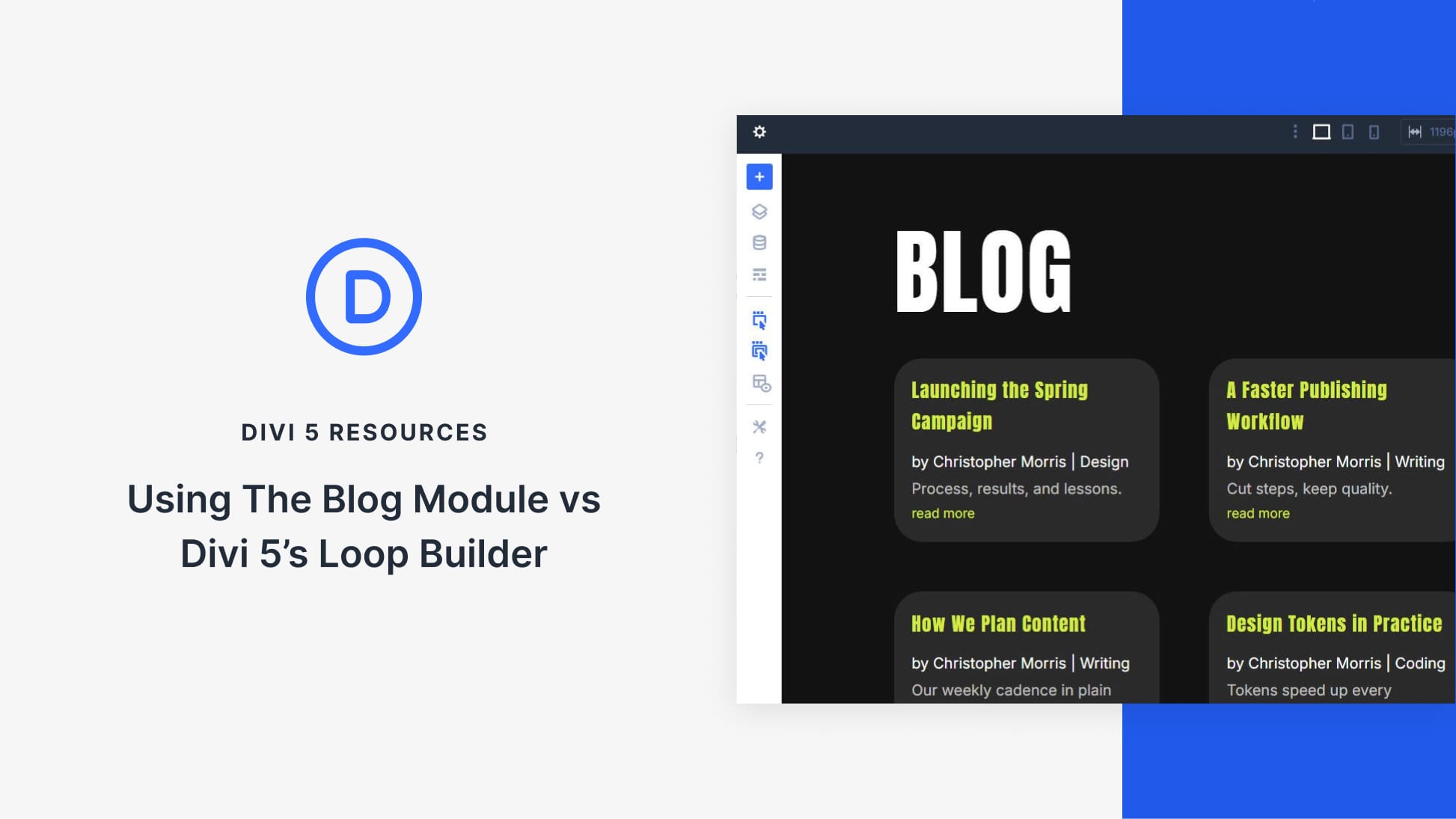Blog
Using The Blog Module vs Divi 5’s Loop Builder

Understanding the Blog Module and Divi 5’s Loop Builder
As web design evolves, tools like Divi continue to shape how we create content on our websites. Two powerful features in Divi are the Blog Module and the Loop Builder. Each serves unique purposes and can enhance your site’s functionality in different ways. This article will explore the distinctions and benefits of these two tools, helping you make informed decisions for your website.
What is the Blog Module?
The Blog Module in Divi simplifies the process of displaying blog posts on your website. It’s particularly useful for those looking to showcase multiple articles in a single section. Here are the key features of the Blog Module:
1. Easy Integration
The Blog Module seamlessly integrates into any Divi layout. Users can insert it into their designs without needing extensive coding knowledge, making it accessible for all skill levels.
2. Customization Options
This module allows you to customize how blog posts appear. You can modify elements like post titles, excerpts, and featured images. Additionally, you have options to display post meta data, such as the author and publish date, contributing to a clearer reader experience.
3. Layout Flexibility
The Blog Module offers various layout styles, including grid, full-width, and multiple-column arrangements. This versatility ensures that your blog posts fit well within any design aesthetic, whether modern or traditional.
What is Divi 5’s Loop Builder?
Divi 5 introduces the Loop Builder, a tool aimed at more advanced users looking for enhanced customizability. The Loop Builder enables a more dynamic approach to displaying posts and content. Below are its standout features:
1. Advanced Content Control
Unlike the Blog Module, the Loop Builder provides granular control over content display. Users can define specific conditions for what content appears, allowing for personalized user experiences. For example, you can display posts based on categories, tags, or even custom criteria.
2. Creation of Unique Templates
The Loop Builder allows designers to create bespoke templates for various content types. This means you can maintain consistent branding while showcasing content differently, enhancing the overall user journey.
3. Dynamic Content Options
With the Loop Builder, you can utilize dynamic content, which means the displayed content can automatically update based on new posts or changes made within your site. This feature is ideal for sites that frequently update their content.
Comparing the Blog Module and Loop Builder
Now that we’ve explored the individual features of the Blog Module and Loop Builder, it’s time to compare them directly. Understanding their differences will help you determine which is best suited for your needs.
Purpose and Usability
The Blog Module is ideal for users who want a straightforward way to display blog content without complex customization needs. It’s easy to implement and offers sufficient options for basic blogs. In contrast, the Loop Builder serves those who require advanced placement and presentation of content, making it a better choice for more complex websites or those requiring high levels of customizability.
Design Flexibility
While both tools offer design flexibility, the methods of achieving this differ. The Blog Module allows for layout changes through predefined designs, while the Loop Builder enables the creation of unique templates for individual posts. This means the Loop Builder can facilitate tailored designs that align closely with your brand.
Performance and Speed
Both features are optimized for performance, but the Blog Module may load faster due to its simpler structure. The Loop Builder’s advanced functionalities might introduce more complexity, affecting load times on some occasions. Therefore, for basic blogging needs, the Blog Module may offer a slight advantage in speed.
When to Use Each Tool
Use the Blog Module When:
- You have a straightforward blog with traditional post layouts.
- You want to get up and running quickly without extensive customization.
- You prefer a user-friendly interface that requires little technical know-how.
Use the Loop Builder When:
- Your website requires unique templates for different content types or categories.
- You want more control over how individual items are displayed across your site.
- Your website frequently updates its content and you need dynamic elements.
Best Practices for Blog Modules and Loop Builder
Regardless of which tool you choose, employing best practices can maximize your site’s effectiveness. Here are some strategies tailored to each feature:
For the Blog Module:
-
Optimize for Readability: Choose fonts and colors that enhance readability for users. Clear headings, bullet points, and engaging visuals can help retain visitors.
- Use Categories Wisely: If your blog covers varied topics, utilize categories effectively. This not only aids navigation but helps search engines rank your content better.
For the Loop Builder:
-
Create Cohesive Templates: When designing templates, maintain consistent branding elements such as colors, logos, and font choices to create a unified experience.
- Leverage Dynamic Content: Use the Loop Builder’s dynamic options to keep your content fresh. Automated updates keep your website relevant and engaging.
Conclusion
The Blog Module and Divi 5’s Loop Builder each have unique strengths that cater to different user needs. While the Blog Module is excellent for those seeking straightforward blog integration, the Loop Builder shines for those desiring advanced customization and dynamic content display.
By understanding the features and advantages of these tools, you can effectively enhance the functionality and appearance of your website. Choose based on your specific requirements, and watch your online presence evolve into a visually appealing and user-friendly platform.

